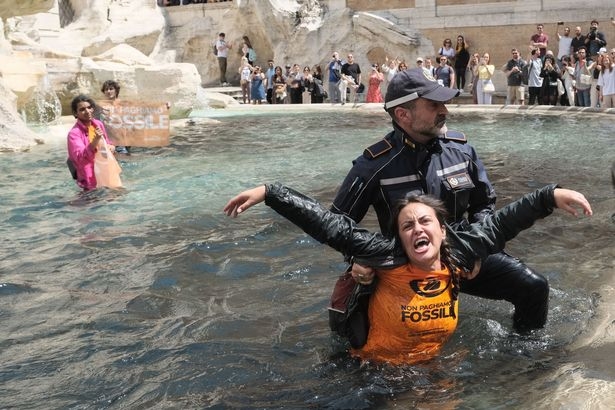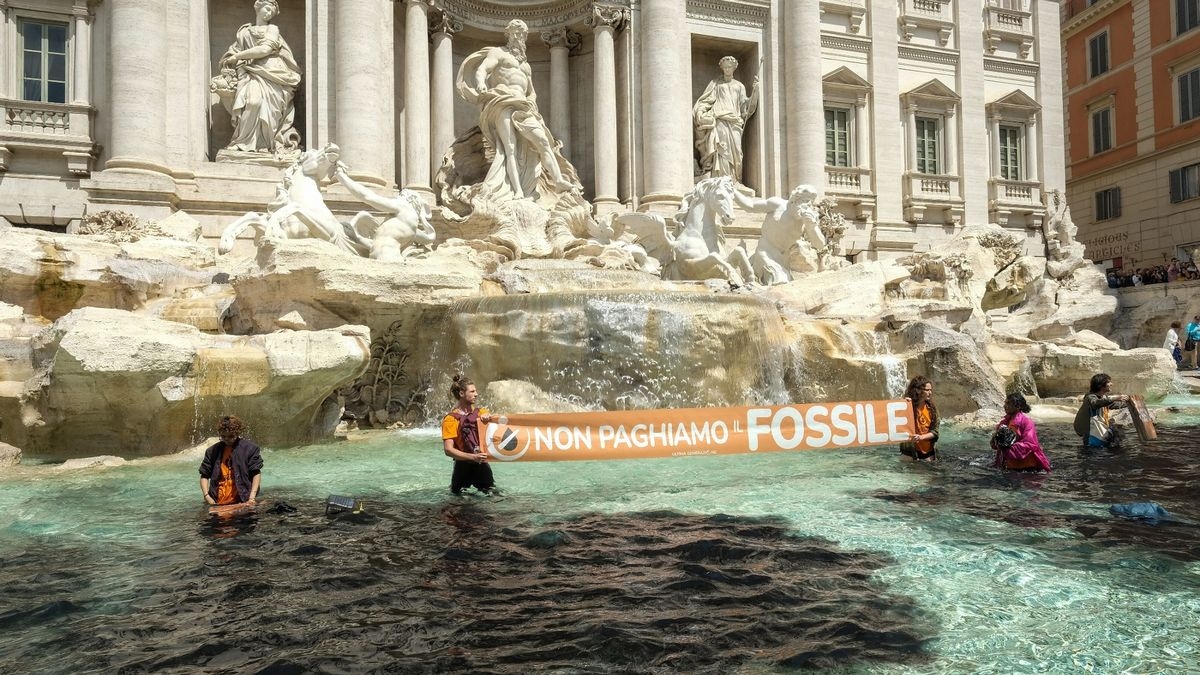In a protest that was both shocking and symbolic, climate change activists dramatically turned the waters of the famed Trevi Fountain in Rome from crystal blue to charcoal black. This unexpected sight emerged on a calm Sunday when around 10 members from the climate advocacy group Ultima Generazione (Last Generation) intervened at this 18th-century late-Baroque marvel, taking their message to the heart of Italy’s capital and raising public concern about the deadly flooding in northern Italy.
Their choice of venue was as deliberate as their method: the Trevi Fountain, a global symbol of Rome, is known for its pristine waters where visitors traditionally toss coins and make wishes. This time, however, the “wishes” were replaced with urgent demands for environmental action and a lamentation for a country they believe is ‘dying’.
The activists unveiled a banner that said, “Let’s not pay for fossil campaigns considering what is happening in Emilia Romagna,” explicitly referencing the catastrophic flooding that recently plagued the region. Experts have increasingly connected these extreme weather events to the larger, looming threat of climate change. This, coupled with other banners proclaiming “Our country is dying,” painted a grim picture of Italy’s current predicament.

The response was immediate and harsh. Without delay, authorities apprehended all the activists involved in the act and have now pressed charges of vandalism against them, as reported by the Rome police. Luisa Regimenti, the councilor responsible for personnel, urban security, local police, and local authorities in the Lazio region, which encompasses Rome, issued a statement denouncing the incident as yet another bold display of eco-vandalism targeting a world-renowned monument.
Rome Mayor Roberto Gualtieri also expressed his disdain for the protest in a tweet, referring to it as an “absurd attack on our artistic heritage.” He expressed concern for the potential permanent damage to the Trevi Fountain, adding that the expensive and complex restoration efforts will cost time, effort, and water. The Mayor’s concerns underscored the gravity of this incident: the fountain, which holds about 300,000 liters of water, must be entirely emptied to remove the discolouration.
This wasn’t the first instance of such radical protest in Rome. In fact, it marked the third time that activists from Ultima Generazione have targeted and dyed famous fountains in the city, including the Fountain of Four Rivers in Piazza Navona and the Barcaccia fountain at the base of the Spanish Steps.
The group has consistently taken responsibility for these acts, using the shocking visual of the charcoal-dyed fountains to convey their message. They expressed their frustration through a tweet following the latest incident, asking, “How much longer do we have to wait for those in government to take concrete action?”
These acts have occurred against a backdrop of mounting criticism of the Italian government’s perceived lack of preparedness for the effects of climate change, particularly following the flooding in northern Italy that led to 14 deaths and displaced over 36,000 individuals. Environmental groups such as Legambiente have issued statements highlighting how the climate crisis is affecting the country with increasingly intense extreme events, putting lives, the environment, and the economy at risk.
The traditional legend of the Trevi Fountain suggests that anyone who tosses a coin into its water will ensure their return to Rome. With the recent activism, however, the fountain has become more than a tourist attraction – it’s now a symbol of Italy’s environmental crisis and a platform for urgent action. It remains to be seen how this controversy will impact future visitors to the fountain, and, indeed, how it will shape the ongoing debate on climate change policy in Italy.
©world-news.biz
